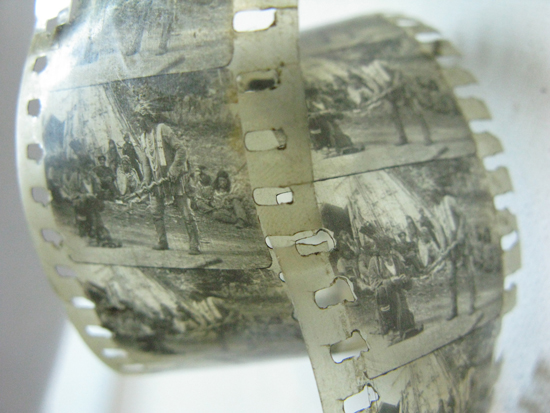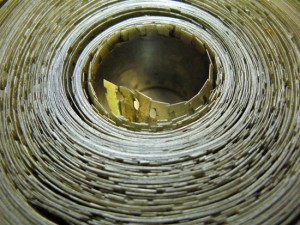
Shot over a hundred years ago, this print of A Pictorial History of Hiawatha was preserved and restored by Julia Nicoll at Colorlab.
My latest piece for The Atlantic, “With 35mm Film Dead, Will Classic Movies Ever Look the Same Again?”, describes the problems repertory theaters are facing in trying to schedule film prints—not digital versions—of classic movies.
I’ve been reporting on the transition from film to digital for over a year now. The pros and cons of the formats have become moot as film slides faster and faster into a niche category. But as someone who has worked in and around movies for thirty years, I am astonished at how quickly the movie industry has shifted.

Even in poor condition, A Pictorial History of Hiawatha had enough visual information for a restoration. Both photos courtesy Julia Nicoll.
Last December I talked to director Alexander Payne about competing formats in “Thinking About the End of Film.” “Flicker is better than glow,” was his conclusion, even as he was fighting studio executives for the right to shoot his next project on film.
In “Film vs. Digital: The IMAX Edition,” esteemed large-format director Greg MacGillivray spoke about the shortcomings to digital formats. A companion piece, “Film vs. Digital: Archivists Speak Out,” addressed concerns about the costs and durability of digital preservation.
No one in the movie industry knows how the digital transition will ultimately shake out. But in the coming weeks and months I’ll try to keep tabs on all the setbacks, advances, and other milestones in the effort to save our film heritage.



Its maddening, trying to keep up with the digital realm. We have gone thru 4 different streaming formats in ten years, having to re digitize every title.
Most of my early documentaries were made in 16mm. We try to archive the old 16mm films in our collection at the University of North Carolina in Chapel Hill. We do our restoration work at Colorlab in Rockville, MD. We also produced a site called “Video Aids to Film Preservation” to show how the old machines and procedures work. Julia Nicholl’s is show there. http://www.folkstreams.net/vafp/index.php
Thanks for your articles and blogging on this issue.
One of the saddest parts of the transition: many small-town movie theaters will be going out of business. In my own area, the theater is a downtown twin. Two digital projectors would cost $200,000 or so, and the owner just cannot afford that. So the doors are closing. This is being repeated in many places.
A nice solution would be to have the film industry provide digital equipment, then collect a $1 or so ticket add-on charge for 10 years, then call it good. Of course, the odds of that are extremely low.
Stanley,
I agree in principle with you ‘solution’. I, personally would be willing to assist/subsidize small venue conversion. Fact is, a local theater in Boston area is running a campaign to assist in paying for digital upgrade.
On the other hand, from Daniel’s article, if the switch to digital is quickly followed with migration to laser, I would fear that the larger entities would “ask” for a similar surcharge to assist their upgrade/conversion.
Going off the rails, I appreciate digital technology, but I tire of movies where someone involved with digital effects suffers from the “Nigel Tufnel” syndrome….. ‘These go to eleven’…. When you see a beautifully crafted FILM, you see the work of a master with technique and skill….. End of Rant…
Hi Mr. Eagan, I saw your article in the Atlantic. I’m very worried as well over the digital transition for films, where only one digital master is used over and over again, especially in regards to color timing. I’m finishing up an analysis of the Superman Blu-Ray remasters, and as you can see, the emphasis on teal and orange means that the colors on the digital “prints” are way off, even to the point of something as basic as Superman’s blue tunic being off. Here’s a link to the youtube comparison: http://www.youtube.com/playlist?list=PLFBEB6343A8AA0935
Pingback: SHOOTING ON FILM: THE FATE OF SUPER 16mm | alexcoxfilms